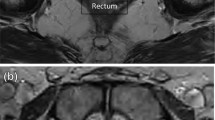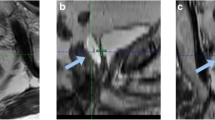Abstract
Purpose
Stereotactic body radiation therapy (SBRT) is increasingly used for prostate cancer, but has morbidity as both the bladder and rectum are radiated during treatment. Our goal was to document and compare lower urinary tract symptoms (LUTS) among men who underwent SBRT with and without SpaceOAR hydrogel (Augmenix, Inc., Bedford, MA).
Methods
We performed a retrospective analysis of 87 men (50 SpaceOAR and 37 non-SpaceOAR) who underwent SBRT. Primary outcomes were patient reported symptoms during radiation therapy, pharmacotherapy usage, and urologic and bowel survey scores up to 6-months post-SBRT.
Results
78% of men were on α-inhibitors at the end of SBRT, an increase from 27.6% baseline usage (p < 0.001). Post-SBRT urinary frequency was more common in the non-SpaceOAR group versus the SpaceOAR group (68% versus 38%, p = 0.006), as was nocturia (35% vs. 8%, p = 0.002). Acute gastrointestinal symptoms did not differ. 58.8% of men were on α-inhibitors at 6-months of follow-up post-SBRT, an increase from 27.6% baseline usage (p < 0.001). Importantly, there was a difference of α-inhibitor use between non-SpaceOAR and SpaceOAR groups at the end of SBRT and at 1.5-, 3-, and 6-months follow up (86% vs. 53% [p = 0.002], 83% vs. 53% [p = 0.005], 72% vs. 49% [p = 0.038], respectively).
Conclusion
LUTS after SBRT remains a significant problem for men undergoing treatment for prostate cancer. LUTS affects men during and up to 6-months following SBRT. Owing to these increased LUTS, preemptive minimally invasive solutions and their mechanisms of protection, including the SpaceOAR, should be further investigated.

Similar content being viewed by others
References
Siegel RL, Miller KD, Jemal A (2020) Cancer statistics, 2020. CA Cancer J Clin 70:7–30. https://doi.org/10.3322/caac.21590
Litwin MS, Tan H-J (2017) The diagnosis and treatment of prostate cancer: a review. JAMA 317:2532–2542. https://doi.org/10.1001/jama.2017.7248
Yilmaz H, Aksu G, Dillioglugil O (2015) External beam radiotherapy for localized prostate cancer. Asian J Androl 17:892–898. https://doi.org/10.4103/1008-682X.156857
Buyyounouski MK, Price RA, Harris EER et al (2010) Stereotactic body radiotherapy for primary management of early-stage, low- to intermediate-risk prostate cancer: report of the American Society for Therapeutic Radiology and Oncology Emerging Technology Committee. Int J Radiat Oncol Biol Phys 76:1297–1304. https://doi.org/10.1016/j.ijrobp.2009.09.078
Weiner PJ, Schwartz D, Shao M et al (2017) Stereotactic radiotherapy of the prostate: fractionation and utilization in the United States. Radiat Oncol J 35:137–143. https://doi.org/10.3857/roj.2017.02026
Brand DH, Tree AC, Ostler P et al (2019) Intensity-modulated fractionated radiotherapy versus stereotactic body radiotherapy for prostate cancer (PACE-B): acute toxicity findings from an international, randomised, open-label, phase 3, non-inferiority trial. Lancet Oncol 20:1531–1543. https://doi.org/10.1016/S1470-2045(19)30569-8
Jackson WC, Silva J, Hartman HE et al (2019) Stereotactic body radiation therapy for localized prostate cancer: a systematic review and meta-analysis of over 6,000 patients treated on prospective studies. Int J Radiat Oncol Biol Phys 104:778–789. https://doi.org/10.1016/j.ijrobp.2019.03.051
Widmark A, Gunnlaugsson A, Beckman L et al (2019) Ultra-hypofractionated versus conventionally fractionated radiotherapy for prostate cancer: 5-year outcomes of the HYPO-RT-PC randomised, non-inferiority, phase 3 trial. Lancet 394:385–395. https://doi.org/10.1016/S0140-6736(19)31131-6
Kim DWN, Cho LC, Straka C et al (2014) Predictors of rectal tolerance observed in a dose-escalated phase 1–2 trial of stereotactic body radiation therapy for prostate cancer. Int J Radiat Oncol Biol Phys 89:509–517. https://doi.org/10.1016/j.ijrobp.2014.03.012
Feng LR, Suy S, Collins SP et al (2018) Comparison of late urinary symptoms following SBRT and SBRT with IMRT supplementation for prostate cancer. Curr Urol 11:218–224. https://doi.org/10.1159/000447222
Hwang ME, Mayeda M, Liz M et al (2019) Stereotactic body radiotherapy with periprostatic hydrogel spacer for localized prostate cancer: toxicity profile and early oncologic outcomes. Radiat Oncol 14:136. https://doi.org/10.1186/s13014-019-1346-5
Karsh LI, Gross ET, Pieczonka CM et al (2018) Absorbable hydrogel spacer use in prostate radiotherapy: a comprehensive review of phase 3 clinical trial published data. Urology 115:39–44. https://doi.org/10.1016/j.urology.2017.11.016
Aminsharifi A, Kotamarti S, Silver D, Schulman A (2019) Major complications and adverse events related to the injection of the spaceoar hydrogel system before radiotherapy for prostate cancer: review of the manufacturer and user facility device experience database. J Endourol 33:868–871. https://doi.org/10.1089/end.2019.0431
Harris PA, Taylor R, Thielke R et al (2009) Research electronic data capture (REDCap)–a metadata-driven methodology and workflow process for providing translational research informatics support. J Biomed Inform 42:377–381. https://doi.org/10.1016/j.jbi.2008.08.010
Janowski E, Chen LN, Kim JS et al (2014) Stereotactic body radiation therapy (SBRT) for prostate cancer in men with large prostates (≥50 cm(3)). Radiat Oncol 9:241. https://doi.org/10.1186/s13014-014-0241-3
Repka MC, Guleria S, Cyr RA et al (2016) Acute urinary morbidity following stereotactic body radiation therapy for prostate cancer with prophylactic alpha-adrenergic antagonist and urethral dose reduction. Front Oncol 6:122. https://doi.org/10.3389/fonc.2016.00122
Kaplan SA (2006) Update on the american urological association guidelines for the treatment of benign prostatic hyperplasia. Rev Urol 8(Suppl 4):S10–S17
Prosnitz RG, Schneider L, Manola J et al (1999) Tamsulosin palliates radiation-induced urethritis in patients with prostate cancer: results of a pilot study. Int J Radiat Oncol Biol Phys 45:563–566. https://doi.org/10.1016/S0360-3016(99)00246-1
Crawford ED, Kavanagh BD (2006) The role of alpha-blockers in the management of lower urinary tract symptoms in prostate cancer patients treated with radiation therapy. Am J Clin Oncol 29:517–523. https://doi.org/10.1097/01.coc.0000225412.24750.4c
Woo JA, Chen LN, Bhagat A et al (2014) Clinical characteristics and management of late urinary symptom flare following stereotactic body radiation therapy for prostate cancer. Front Oncol 4:122. https://doi.org/10.3389/fonc.2014.00122
Song DY, Herfarth KK, Uhl M et al (2013) A multi-institutional clinical trial of rectal dose reduction via injected polyethylene-glycol hydrogel during intensity modulated radiation therapy for prostate cancer: analysis of dosimetric outcomes. Int J Radiat Oncol Biol Phys 87:81–87. https://doi.org/10.1016/j.ijrobp.2012.12.019
Mariados N, Sylvester J, Shah D et al (2015) Hydrogel spacer prospective multicenter randomized controlled pivotal trial: dosimetric and clinical effects of perirectal spacer application in men undergoing prostate image guided intensity modulated radiation therapy. Int J Radiat Oncol Biol Phys 92:971–977. https://doi.org/10.1016/j.ijrobp.2015.04.030
Hamstra DA, Mariados N, Sylvester J et al (2017) Continued benefit to rectal separation for prostate radiation therapy: final results of a phase III trial. Int J Radiat Oncol Biol Phys 97:976–985. https://doi.org/10.1016/j.ijrobp.2016.12.024
Funding
None.
Author information
Authors and Affiliations
Contributions
MNA: protocol/project development, data collection or management, data analysis, manuscript writing/editing. AE: protocol/project development, data collection or management, data analysis, manuscript writing/editing. SMD: protocol/project development, data analysis, manuscript writing/editing. MDS: protocol/project development, data analysis, manuscript writing/editing. SF: protocol/project development, data analysis, manuscript writing/editing. HN: protocol/project development, data analysis, manuscript writing/editing. JK: protocol/project development, data analysis, manuscript writing/editing. BC: protocol/project development, data analysis, manuscript writing/editing.
Corresponding author
Ethics declarations
Conflict of interest
All authors have no conflicts of interest to declare.
Data availability
Data is available from authors upon reasonable request.
Ethical approval
Study was approved by the WCM Institutional Review Board (IRB #1601016896).
Informed consent
Waived.
Additional information
Publisher's Note
Springer Nature remains neutral with regard to jurisdictional claims in published maps and institutional affiliations.
Rights and permissions
About this article
Cite this article
Alshak, M.N., Eidelberg, A., Diaz, S.M. et al. Natural history of lower urinary tract symptoms among men undergoing stereotactic body radiation therapy for prostate cancer with and without a Rectal Hydrogel Spacer. World J Urol 40, 1143–1150 (2022). https://doi.org/10.1007/s00345-022-03953-0
Received:
Accepted:
Published:
Issue Date:
DOI: https://doi.org/10.1007/s00345-022-03953-0




